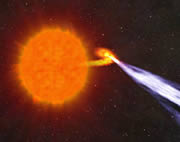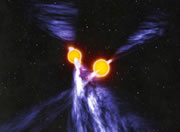Star twinsThe first
double-team of pulsars may reveal secrets of
gravity.
9 January
2004
MARK PEPLOW
 |
|
Artists impression of the
evolution of the binary pulsars. |
| animation | |
Astronomers have realized that a rare set of double
stars is made up of two pulsars1.
This unique discovery will allow them to test Einstein's
theory of relativity in novel ways, and to better
understand the energy beams that pulsars generate.
"This is a hugely significant discovery," says Robert
Massey of the Royal Observatory, Greenwich, in London,
UK. Einstein predicted the existence of gravitational
waves, but they have never been directly observed.
"There aren't many objects out there that could be a
copious enough source of gravitational waves, but this
is one of them," he says.
An international team of scientists first published
information about the binary system in December2,
but they thought it contained one pulsar and one neutron
star, a relatively exotic combination in itself. Pulsars
- spinning stars that emit directed beams of light and
radiation - are often called the lighthouses of the
cosmos. Neutron stars are the incredibly dense debris
left after a star explodes as a supernova. Discovering
that the smaller neutron star was also a pulsar makes
the system even more unusual.
Their initial mistake was simply a matter of bad
luck, says Andrew Lyne, director of Jodrell Bank
Observatory in Macclesfield, UK, and lead author on the
initial study. As the two pulsars spiral around each
other, the larger star blasts away at its sibling's
magnetic field, distorting its radiation beam. "We only
spent about four minutes looking at each part of the
sky. It was just bad luck that the first time we looked
at the system, the smaller pulsar was too dim to see,"
says Lyne.
While the larger pulsar rotates once every 23
milliseconds, its partner makes just one rotation every
2.8 seconds - slightly slower than a record on a
turntable.
 |
|
The pulsars in their current
state. |
| animation | |
Lyne and his colleagues think that the system was
formed by the larger pulsar sucking matter away from a
companion star, spinning faster and faster as it did so.
The companion then turned into a second, smaller pulsar
after a supernova explosion.
Binaries such as these are thought to emit
gravitational waves as the stars circle one another,
losing energy until they meet in an intense collision.
The end of the pulsars' dance of death is expected in
about 85 million years time, and will be marked by one
last, enormous burst of gravity waves.
Four different effects beyond those explained by
simple newtonian gravity have already been measured
using the binary stars and are consistent with
Einstein's theory of gravity.
The orientation of the two pulsars means that the
radiation from one shines through the magnetic field of
the other, giving scientists an unprecedented
opportunity to work out what happens in the region
immediately around a pulsar. "In the past we've only
been able to guess at things like this," says Lyne. "Now
we can actually observe it." | 
